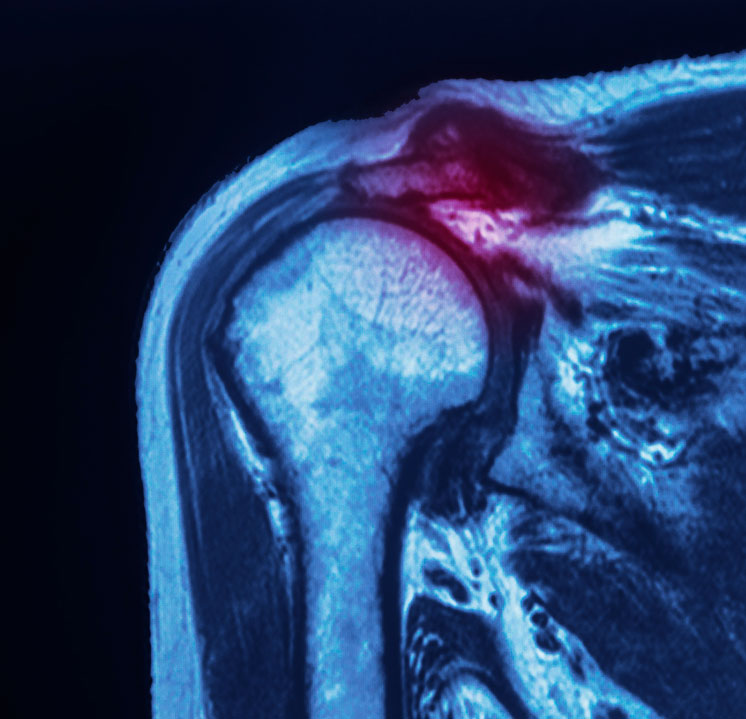Slap Tears
A SLAP tear is a shoulder injury that affects the superior labrum, which is a ring of cartilage around the socket of the shoulder joint. The term 'SLAP' refers to Superior Labrum Anterior and Posterior, indicating that the tear can occur in either the front (anterior) or the back (posterior) of the labrum.

The Shoulder Anatomy
Your shoulder joint comprises three bones - your upper arm bone (humerus), your shoulder blade (scapula), and your collarbone (clavicle). The ball-shaped head of your upper arm bone fits into a rounded socket in your shoulder blade (glenoid).
The labrum is a strong, fibrous tissue that surrounds the outside edge of the glenoid and plays a crucial role in stabilising your shoulder. It deepens the socket and supports the shoulder joint by attaching many of the ligaments in the shoulder. Additionally, one of the tendons from the biceps muscle in the arm connects to the labrum.
Types of SLAP Tears
SLAP tears are categorised into four types based on the degree of the tear and the involvement of the biceps tendon:
- Type I: The labrum frays with intact attachment to the shoulder socket.
- Type II: Both the labrum and the biceps tendon detach from the shoulder socket.
- Type III: A bucket-handle tear of the labrum occurs without involvement of the biceps tendon.
- Type IV: A bucket-handle tear of the labrum accompanied by the detachment of both the labrum and the biceps tendon.
Don't let shoulder pain or a possible SLAP tear affect your daily life.
Get evaluated by Dr Yung, a shoulder subspecialist, at 62355225 today.
What Causes SLAP Tears?
Injuries to the superior labrum can occur due to either acute trauma or repetitive shoulder motion. Common causes of injury include:
- Trauma: Resulting from a fall on an outstretched arm or a direct blow to the shoulder.
- Repetitive throwing motions: Associated with overhead sports like javelin throw and volleyball.
- Heavy lifting: Resulting from manual labour or weightlifting.
- Hyperextension: Caused by overextending the shoulder joint.
- Degeneration of the labrum: In patients over 30-40 years old, superior labrum tearing or fraying may be a result of normal ageing.
Signs & Symptoms
The symptoms of a SLAP tear closely resemble those of various other shoulder problems. These symptoms may include:
- Popping, locking, catching, or grinding sensation
- Acute deep pain in the shoulder joint
- Decreased range of motion
- Decreased shoulder strength and endurance
- Pain when trying to sleep on the injured shoulder
Diagnosis of SLAP Tears
SLAP tears can be misdiagnosed as they may resemble instability and rotator cuff disorders. Therefore, a detailed examination is necessary for an accurate diagnosis.
- Medical historyThis includes details about the onset of symptoms, activities that affect one’s symptoms, participation in overhead activities, past shoulder injuries, and more.
- Physical examinationThese tests assess shoulder mobility, stability, and strength. Some tests aim to elicit SLAP tear symptoms, while others aid in diagnosing specific shoulder issues.
- Imaging testsImaging tests such as X-rays, MRI scans, and diagnostic arthroscopy are crucial for visualising the shoulder's internal structures and confirming SLAP tears.
How is a SLAP Tear Treated?
Treatment Options
In most cases, the initial approach to treating SLAP injuries is non-surgical and involves:
- Rest, Ice, and Activity Modification: Providing the injured shoulder with adequate rest, avoiding actions that exacerbate the injury, and applying ice to facilitate the natural healing process.
- Pain and Anti-Inflammatory Medication: Alleviating symptoms by reducing pain and inflammation through medication.
- Braces and Slings: Immobilising the shoulder with a brace or sling to provide stability and support, promoting faster healing.
- Physiotherapy: Engaging in specific exercises to restore movement, strengthen muscles, and improve overall shoulder function.
- Surgery: If non-surgical treatment proves unsuccessful or the tear is severe, surgical intervention may be recommended by your orthopaedic surgeon. This could involve either removing the torn part of the labrum or reattaching it using sutures.
Post-Operative Rehabilitation
Following a SLAP repair, your shoulder will be immobilised for a brief period, depending on the severity of the injury and the complexity of the surgery. Physiotherapy is also a key part of recovery. Typically, this starts with a range of motion activities to restore flexibility and prevent stiffness. After achieving sufficient motion, strength training becomes a focus, aiming to strengthen the shoulder muscles and the rotator cuff.
For overhead athletes seeking a return to sports, a sport-specific throwing programme can be tailored to individual goals and the recovery process. Your doctor will discuss with you the appropriate time to safely resume sports activities.
With over 30 years of experience and a subspecialty fellowship in shoulder surgery (USA), Dr Yung is skilled in the treatment of SLAP tears.
Call 62355225 to make an appointment today.
FAQs about SLAP Tears

